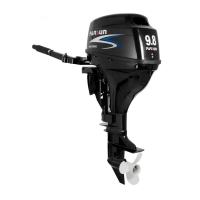
Do you have a question about the Parsun F9.8BM and is the answer not in the manual?
| Power Output | 9.8 HP |
|---|---|
| Fuel Tank Capacity | 12 L |
| Starting System | Manual |
| Gear Ratio | 2.08:1 |
| Full Throttle Operating Range | 5000 - 6000 RPM |
| Cylinder | 2 |
| Max. Output | 9.8 HP |
| Weight | 26 kg |
| Shaft Length | Short (381 mm / 15 in) |
| Gear Shift | F-N-R (Forward-Neutral-Reverse) |
Locates and records the outboard motor's unique serial number for identification and part ordering.
Details how to find and record the engine's specific serial number for reference.
Explains engine power reduction and potential issues like hard starting at high altitudes.
Illustrates and labels the primary external parts of the outboard motor for identification.
Provides detailed technical data including engine size, dimensions, oil, and spark plug specifications.
Covers recommended gasoline types, safety precautions, and steps for refueling the outboard motor.
Advises on choosing the correct propeller pitch based on boat load and desired engine speed for optimal performance.
Guides on mounting the outboard motor correctly on the boat's center line, considering safety and stability.
Explains how to set the correct mounting height of the outboard motor for optimal running efficiency and to prevent cavitation.
Details the process of securely clamping the outboard motor to the transom, including safety warnings for loose screws.
Outlines the recommended steps and duration for breaking in a new engine to ensure proper mating of parts.
Lists essential checks for fuel, controls, engine mounting, and propeller before starting the motor.
Provides instructions and safety warnings for filling the outboard motor's fuel tank with gasoline.
Step-by-step guide on how to start the outboard motor, including fuel connection and primer pump use.
Explains the procedure for warming up the engine after starting, including throttle settings and checking water flow.
Details the procedures for changing the gear state of the outboard motor.
Details the steps to shift the outboard motor from neutral to forward gear safely.
Provides instructions for shifting into reverse gear, emphasizing slow operation and throttle limits.
Explains how to use the tiller handle for steering and controlling the outboard motor.
Explains how to change direction using the tiller handle and adjust speed via the throttle grip.
Describes how to adjust the throttle friction for preferred resistance and maintain a set speed.
Outlines the procedure for safely stopping the outboard motor, including cooling down and closing fuel vents.
Explains how to adjust the outboard motor's trim angle using the clamp bracket for optimal boat performance.
Provides instructions for tilting the outboard motor up or down.
Details the process for tilting the outboard motor upwards for storage or protection, ensuring safety.
Describes the procedure for lowering the outboard motor from its tilted position, including steering friction adjustment.
Provides guidance on operating the motor in various water conditions.
Provides guidance on operating the motor in shallow water, including tilting and cooling water intake precautions.
Advises on flushing cooling passages with fresh water after operating in salt water to prevent clogging.
Illustrates the locations requiring greasing for proper lubrication and maintenance of the outboard motor.
Explains how to clean, adjust the gap, and replace spark plugs for optimal engine performance.
Details checks for fuel lines, filters, and potential leaks, emphasizing safety and professional repair if issues are found.
Guides on checking and verifying the engine's idling speed specification after warming up.
Provides step-by-step instructions for draining, replacing, and checking the engine oil level, including safety precautions.
Ensures grounding wires are secure and connectors are properly engaged for electrical system integrity.
Advises checking for exhaust, water, and oil leaks around engine components, recommending dealer consultation if found.
Details how to inspect the propeller blades, shaft, and splines for wear, damage, or foreign entanglement.
Step-by-step guide on safely removing and installing the propeller, including washer and cotter pin procedures.
Covers procedures for maintaining and changing the outboard motor's gear oil.
Instructions for draining and refilling gear oil, including safety warnings about working under a tilted motor.
Outlines the procedure for cleaning the fuel tank using solvent, emphasizing safety around sparks and ventilation.
Advises periodic inspection of anodes for scales and replacement if necessary to prevent corrosion.
Recommends checking the fitting of the top cowling and having loose ones repaired by a dealer.
Provides guidelines on securely transporting the outboard motor upright or laid down, with safety cautions.
Details procedures for storing the motor for extended periods, including upright storage and environmental considerations.
Steps to follow if the outboard motor hits an object, including immediate stop, inspection, and dealer check.
Describes how to start the engine using an emergency starter rope when the primary starter fails.
Outlines immediate steps for a submerged outboard motor, including washing, draining, and contacting a dealer.
Lists possible reasons and recovery actions for when the starter motor fails to operate.
Addresses issues preventing engine start despite the starter operating, covering fuel, spark plugs, and ignition.
Helps diagnose and resolve problems causing the engine to idle unevenly or stall, related to fuel and ignition.
Identifies causes for reduced engine power, such as incorrect oil, fuel issues, or propeller problems.
Helps diagnose and fix causes of excessive engine vibration, including propeller and mounting issues.